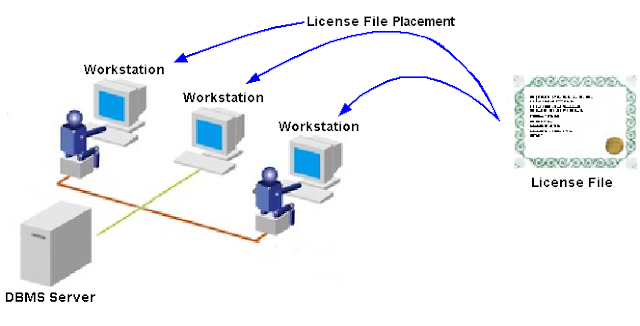Networks are made up of lots of different components, but the three most common network entities are :-
Host:- A host is a computer connected to a computer network. A network host may offer information resources, services, and applications to users or other nodes on the network.
Server:- In the truest sense, a server does exactly what the name implies, it provides resources to the client on the network. Server are typically powerful computers that run the software that controls and maintain the network. This is also known as network operating software. Servers are often specialized to a single purpose.Here are some example of servers that are dedicated to a single task:
File Server: holds and distributes files
proxy Server: performs a function on behalf of other computers
Application Server: hosts a network application.
Web Server: holds and delivers web pages and other web content using HTTP.
Print Server: controls and manages one or more printers in the network.
File Server: holds and distributes files
proxy Server: performs a function on behalf of other computers
Application Server: hosts a network application.
Web Server: holds and delivers web pages and other web content using HTTP.
Print Server: controls and manages one or more printers in the network.
Workstations:- In the network environment, the term workstation normally refers to any computer that is connected to the network and used by an individual to do work. Workstations can be clients, but not all clients are workstations. for example, a printer can request resources from the network, but it is a client, not a workstation.
Types of Networks :-
1. Local Area network (LAN):
By definition, a local area network (LAN) is limited to a specific area, usually an office, and cannot extend beyond the boundaries of a single building. The first LANs were limited to a range (from a central point to the most distant computer) of 185 meters (about 600 feet) and no more than 30 computers. Today's technology allows a larger LAN, but practical administration limitations require dividing it into small, logical areas called workgroups. A workgroup is collection of individuals (for ex, a HR department) who share the same files and databases over the LAN.Typically LANs are half-duplex, although some LANs are full duplex.
2. Wide Area Network (WAN):
A WAN is any network that crosses metropolitan, regional or national boundaries. Most networking professionals define a WAN as any network that uses routers and public network links. WANs use full-duplex communication. Internet is the largest WAN network on the planet earth.
In half-duplex communication, information is transferred in both the directions but only one direction at a time, while in full-duplex communication can be happen in both the directions simultaneously.
3. Metropolitan Area Network (MAN):
A MAN is optimized for a larger geographical area than a LAN, ranging from several blocks of buildings to entire cities. MANs can also depend on communications channels of moderate-to-high data rates. A MAN might be owned and operated by a single organization, but it usually will be used by many individuals and organizations. MANs might also be owned and operated as public utilities. They will often provide means for internetworking of local networks.
3. Metropolitan Area Network (MAN):
A MAN is optimized for a larger geographical area than a LAN, ranging from several blocks of buildings to entire cities. MANs can also depend on communications channels of moderate-to-high data rates. A MAN might be owned and operated by a single organization, but it usually will be used by many individuals and organizations. MANs might also be owned and operated as public utilities. They will often provide means for internetworking of local networks.
4. Campus Area Network (CAN):
It is used to inter-connect networks in limited geographical locality like university campus, military bases, or organizational campuses etc. It can be taken as the metropolitan network that has the specific settings at the small area just like a computer lab in the university.
A network which is created by attaching storage devices such as disk arrays and tapes to a common server so that the storage devices appear to be confined to operating system is known as storage area network. Data in SAN can be stored using two basic modules as DAS(Direct Attached Storage) and NAS (Network Attached Storage). In DAS, device is directly attached to a server without any intermediary network involved. while in NAS , device is connected to a server using network components, it may be also possible that storage device physically away from the server, but logically it is directly attached to a server. NAS uses hubs, bridges, switches.
| 5. Storage Area Network (SAN): |
One thing you must know:
The Internet, with a capital "I," refers to the network that began its life as the ARPAnet and continues today as, roughly, the confederation of all TCP/IP networks directly or indirectly connected to commercial U.S. backbones. Seen up close, it's actually quite a few different networks-commercial TCP/IP backbones, corporate and U.S. government TCP/IP networks, and TCP/IP networks in other countries-interconnected by high-speed digital circuits.
A lowercase internet, on the other hand, is simply any network made up of multiple smaller networks using the same internetworking protocols. An internet (little "i") isn't necessarily connected to the Internet (big "I"), nor does it necessarily use TCP/IP as its internetworking protocol. There are isolated corporate internets, for example.
A lowercase internet, on the other hand, is simply any network made up of multiple smaller networks using the same internetworking protocols. An internet (little "i") isn't necessarily connected to the Internet (big "I"), nor does it necessarily use TCP/IP as its internetworking protocol. There are isolated corporate internets, for example.


No comments:
Post a Comment